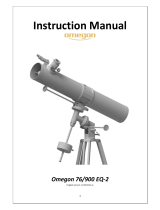
7
O
O
p
p
t
t
i
i
o
o
n
n
a
a
l
l
A
A
c
c
c
c
e
e
s
s
s
s
o
o
r
r
i
i
e
e
s
s
Celestron offers a full line of optional accessories for your telescope. Please refer to the Celestron Accessory Catalog
(#93685) for a complete description, or logon to our web site at www.celestron.com
.
Diagonal, Hybrid Mirror 90° (.96 to 1¼") #94106 - The economy Hybrid Mirror Diagonal (90°) provides a cost
effective way to upgrade telescopes supplied with .96" eyepieces, to higher quality 1¼" eyepieces.
Diagonal, Erect Image # 94113-A -An Amici prism design that allows you to look into the telescope at a 45° angle, at
images that are oriented properly, meaning the image is upright and correct from left to right.
Eyepieces – An assortment of 1¼” eyepieces are available to give you a wide range of
magnifications.
• OMNI Plössl - Plössl eyepieces have a 4-element lens designed for low-to-high power observing.
The Plössls offer razor sharp views across the entire field, even at the edges! In the 1-1/4" barrel
diameter, they are available in the following focal lengths: 4mm, 6mm, 9mm, 12.5mm, 15mm,
20mm, 25mm, 32mm and 40mm.
• Ultima – Ultima is not really a design, but a trade name for our 5-element, wide field
eyepieces. In the 1-1/4” barrel diameter, they are available in the following focal lengths:
5mm, 7.5mm, 10mm, 12.5mm, 18mm, 24mm, 30mm, 35mm, and 42mm. These eyepieces
are all parfocal. The 35mm Ultima gives the widest possible field of view with a 1-1/4”
diagonal.
Filters, Eyepiece - To enhance your visual observations of solar system objects, Celestron offers a wide range of
colored eyepiece filter sets that thread into the 1-1/4" oculars. Available sets are:
#94119-10 – Orange, Light Blue, ND13%T, Polarizing (#s 21, 80A, 96ND-13, Polarizing)
#94119-20 - Deep Yellow, Red, Light Green, ND25% T (#s 12, 25, 56, 96ND-25)
#94119-30 - Light Red, Blue, Green, ND50% T (#s 23A, 38A, 58, 96ND-50)
#94119-40 - Yellow, Deep Yellow, Violet, Pale Blue (#s 8, 15, 47, 82A)
Flashlights - #93588 LED (light emitting diode) flashlights conveniently allow you to read star maps without
diminishing your night vision. Both feature adjustable brightness and are small and lightweight, (#93592 is only 6 inches
long, and weighs in at a only 3 ounces).
Light Pollution Reduction (LPR) Filter (#94126A) - A 1¼” filter that threads into a 1¼” eyepiece, designed to
enhance your views of deep-sky astronomical objects when observed from urban areas. The LPR filter selectively
reduces the transmission of certain wavelengths of light, specifically those produced by artificial lights. This includes
mercury, and high and low pressure sodium vapor lights. Additionally, it blocks unwanted natural light (also known as
sky glow).
Sky Maps (#93722) – When learning the night sky, Celestron Sky Maps offer just the
guidance you need. The maps show all the constellations and brighter deep-sky objects
and are printed on heavy, moisture-resistant paper for durability. The front cover
features a rotating planisphere, indicating when specific constellations are visible.
Peterson First Guides® - Astronomy (#93728)
A simplified field guide to the stars, the planets and the universe featuring full color maps showing the positions of the
stars throughout the year. This useful guide also includes beautiful constellation paintings, photographs, and clear,
concise descriptions of stars, the planets, the sun, the moon, comets, black holes, galaxies and more.










